

2022年亚洲光电子会议(Photonics Asia 2022)在2022年11月27-29日于线上举行。本次大会由SPIE(国际光学工程学会)和COS(中国光学学会)联合主办。会议共设立15个专题,涵盖光学及光学工程领域近100个研究方向。
为了更好的学术交流与参会体验,每个专题将呈现优选报告直播,涵盖国内外知名光学专家,与您齐聚线上交流。
届时欢迎广大代表参加此次光学盛会!
Digital forum将于12月5-11日开始,届时请参会代表前往SPIE网站观看报告视频与海报。
.gif)
.gif)
| Plenary Speakers | |
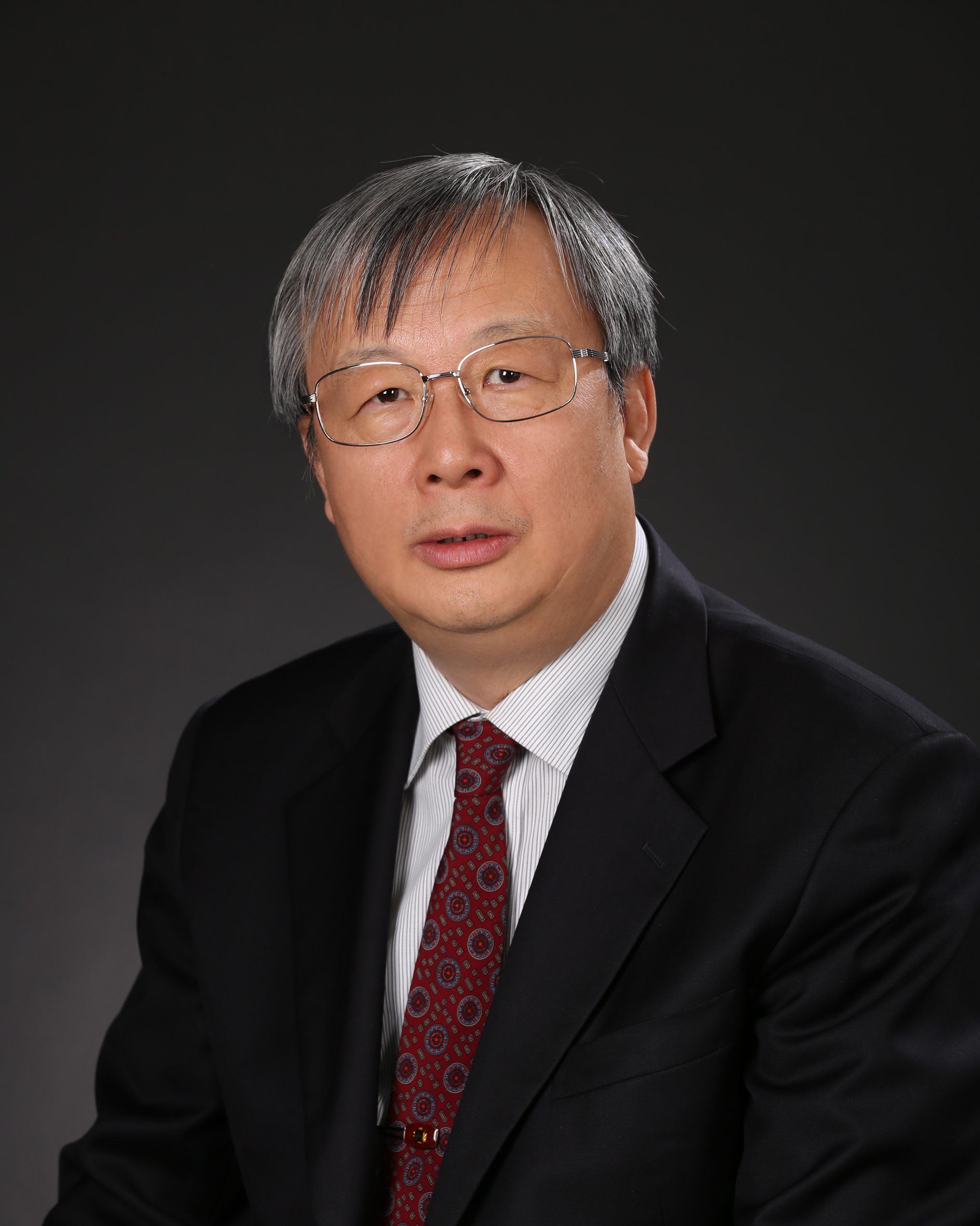 |
Yi Luo |
|
Tsinghua University (China) |
|
| Plenary Presentations Nature of light wave and photonic devices |
|
 |
Jennifer K. Barton |
|
Biomedical Engineering at Univ of Arizona (United States) |
|
| Plenary Presentations Early detection of cancer with miniature optical endoscopes |
|
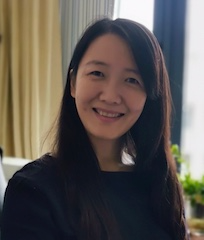 |
Qiongyi He |
|
Peking University (China) |
|
| Plenary Presentations Quantum steering and its applications in quantum information |
|
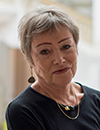 |
Halina Rubensztein-Dunlop |
|
Quantum Science Laboratory, The University of Queensland (Australia) |
|
| Plenary Presentations Sculpted light in optical micromanipulation and quantum atom optics |
|
.gif)
| GENERAL CHAIRS | |
 |
Anita Mahadevan-Jansen SPIE President Vanderbilt University (United States) |
 |
Qihuang Gong COS President Peking University (China) |
|
| |
.gif)
|
Conference 12310 Advanced Lasers, High-Power Lasers, and Applications XIII Chair(s): Jun Liu; Shibin Jiang; Ingmar Hartl 27 - 29 November 2022 Conference 12311 Semiconductor Lasers and Applications XII Chair(s): Wei Li; Werner H. Hofmann; Yikai Su 27 - 28 November 2022 Conference 12312 Advanced Laser Processing and Manufacturing VI Chair(s): Rongshi Xiao; Minghui Hong; Jianhua Yao; Yuji Sano 27 - 28 November 2022 Conference 12313 Photonics for Energy II Chair(s): Haizheng Zhong; Rui Zhu; Samuel D. Stranks; Jianpu Wang 27 - 28 November 2022 Conference 12314 Optoelectronic Devices and Integration XI Chair(s): Xuping Zhang; Baojun Li; Changyuan Yu; Xinliang Zhang 28 - 29 November 2022 Conference 12315 Optical Design and Testing XII Chair(s): Yongtian Wang; Tina E. Kidger; Rengmao Wu 21 - 22 October 2022 Conference 12316 Advanced Optical Imaging Technologies V Chair(s): Xiao-Cong Yuan; P. Scott Carney; Kebin Shi 27 - 28 November 2022 Conference 12317 Optoelectronic Imaging and Multimedia Technology IX Chair(s): Qionghai Dai; Tsutomu Shimura; Zhenrong Zheng 28 - 29 November 2022 Conference 12318 Holography, Diffractive Optics, and Applications XII Chair(s): Changhe Zhou; Ting-Chung Poon; Liangcai Cao; Hiroshi Yoshikawa 28 - 29 November 2022 Conference 12319 Optical Metrology and Inspection for Industrial Applications IX Chair(s): Sen Han; Gerd Ehret; Benyong Chen 28 - 29 November 2022 Conference 12320 Optics in Health Care and Biomedical Optics XII Chair(s): Qingming Luo; Xingde Li; Ying Gu; Dan Zhu 27 - 29 November 2022 Conference 12321 Advanced Sensor Systems and Applications XII Chair(s): Minghong Yang; Gang-Ding Peng; Xinyu Fan 28 November 2022 Conference 12322 Nanophotonics, Micro/Nano Optics, and Plasmonics VIII Chair(s): Zhiping Zhou; Kazumi Wada; Limin Tong; Zheyu Fang; Takuo Tanaka 28 November 2022 Conference 12323 Quantum and Nonlinear Optics IX Chair(s): Qiongyi He; Dai-Sik Kim; Chuan-Feng Li 27 - 28 November 2022 Conference 12324 Infrared, Millimeter-Wave, and Terahertz Technologies IX Chair(s): Cunlin Zhang; Xi-Cheng Zhang; Masahiko Tani 27 - 28 November 2022 |
| GENERAL CHAIRS | |
 |
Anita Mahadevan-Jansen SPIE President Vanderbilt University (United States) |
 |
Qihuang Gong COS President Peking University (China) |
|
| |
会议手册 [NEW]
开幕式及大会报告回放链接:https://www.koushare.com/lives/room/165831
2022亚洲光电子会议通知
注册系统已开通:http://t1.ink/f/fxc0mk
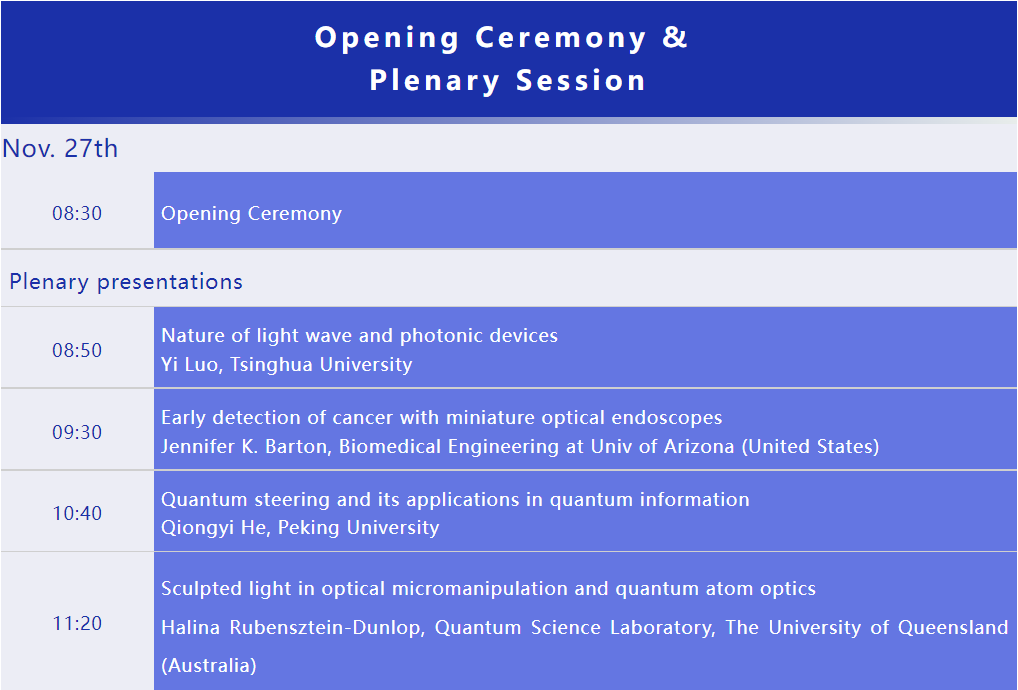
优选报告日程
27 November 2022
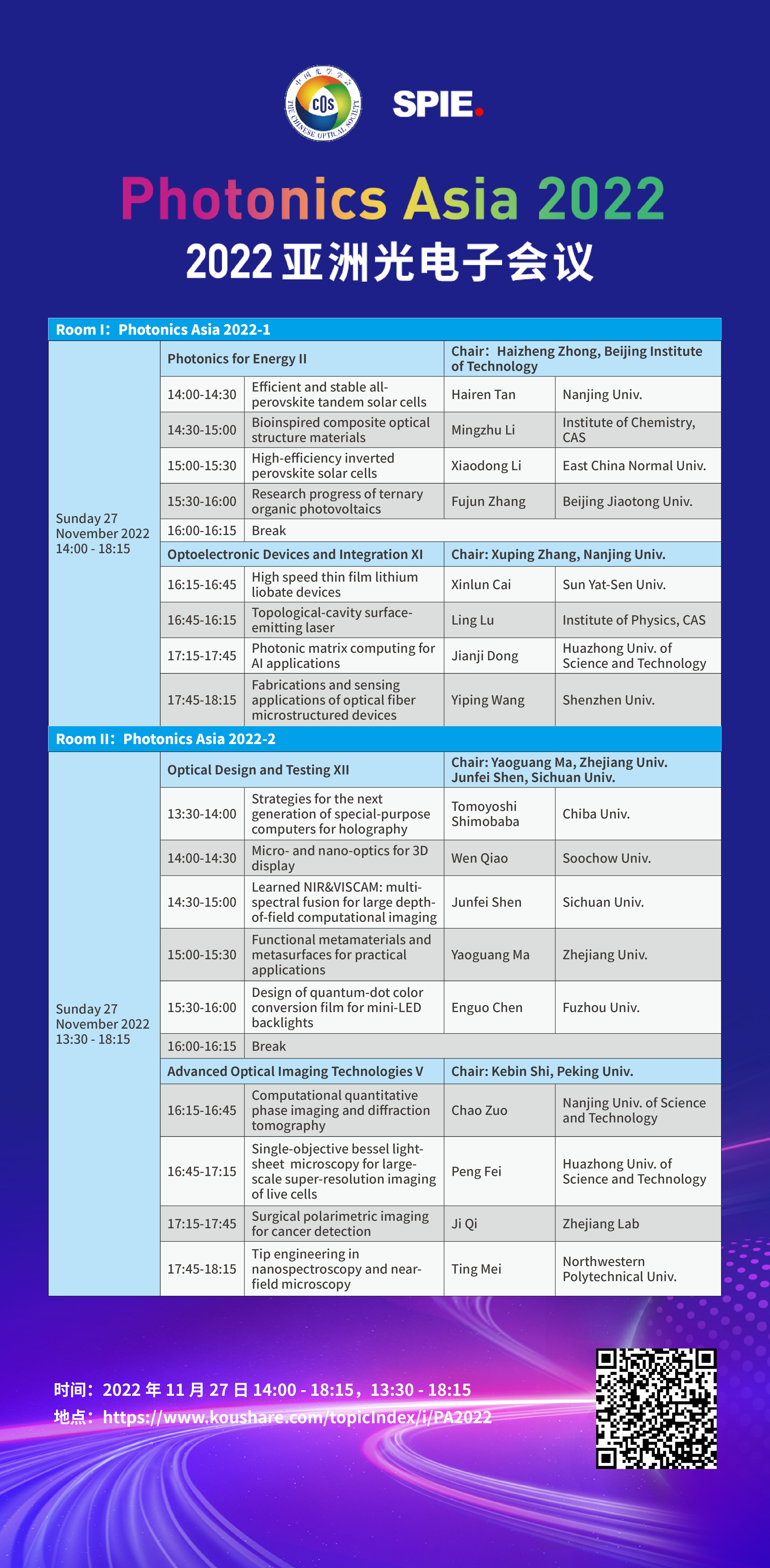
28 November 2022

29 November 2022

 |
Yi Luo |
| Tsinghua University (China) |
|
| Nature of light wave and photonic devices | |
|
Abstract: Light wave is of some attractive natures such as huge bandwidth, the possibility to control optical field 2D parallelly by optical free form surface and optical diffraction device. Such nature is very important to many applications such fiber telecommunications, high speed 3D sensing Lidar systems, and VR/AR components. In this talk, those optical devices based on the nature of light wave, including ultra-high speed DFB laser integrated with EA modulators, ultra-wide band lithium niobate thin film optical modulators, and ultra-high speed photodetectors, will be introduced. Biography: Yi LUO, Professor of Electronic Engineering, Tsinghua University, Beijing, Vice Director of Tsinghua National Laboratory of Information Science and Technology, Oversea Editor of Japanese Journal of Applied Physics, Oversea Editor of Applied Physics Express, and Program committee member of ECOC (European Conference on Optical Communication). He has a long-term research focus on basic theory of semiconductor optoelectronic devices, fabrication technology, application technology development and training. He has obtained many outstanding contributions in optoelectronic devices to support broadband fiber optic network and semiconductor lighting technology. Prof. Luo has two national technology invention prize two (ranked 1), one national science and technology progress Award (ranked 2), three provincial-level award (ranked 1). |
|
 |
Jennifer K. Barton |
| Biomedical Engineering at Univ of Arizona (United States) |
|
| Early detection of cancer with miniature optical endoscopes | |
|
Abstract: With multiple mechanisms of contrast, high sensitivity, high resolution, and the possibility to create miniature, inexpensive devices, light-based techniques have tremendous potential to positively impact cancer detection and survival. Many organs of the body can be reached in a minimally-invasive fashion with small flexible endoscopes. Some organs, such as the fallopian tubes and ovaries, require extremely miniature (sub-mm) and flexible endoscopes to avoid tissue cutting. Additionally, some modalities, such as side-viewing optical coherence tomography, are naturally suited to miniature endoscopes, whereas others like forward-viewing reflectance or fluorescence imaging, may require performance tradeoffs. The development of small, robust and fiber-delivered advanced light sources, miniature fiber bundles, and sensitive detectors has aided the development of novel miniature endoscopes. We have incorporated these technological advances to build endoscopes for challenging applications, especially early detection of ovarian cancer. Biography: Jennifer K. Barton is known for her development of miniature endoscopes that combine two novel imaging techniques: optical coherence tomography and fluorescence spectroscopy. She also evaluates the suitability of these optical techniques for detecting early cancer development in patients and pre-clinical models. She is particularly interested in colon and ovarian cancer, and conducted the first pilot test of optical coherence tomography in women, seeking to determine if this technique could identify the early stages of cancerous development. Dr. Barton has also conducted significant research into laser-tissue interaction and dynamic optical properties of blood. This work laid the groundwork for a novel therapeutic laser to treat disorders of the skin’s blood vessels (port wine stains). She has published over 110 peer-reviewed journal papers in these and related research areas. Dr. Barton was inaugural Head of the Department of Biomedical Engineering and previously served as Associate Vice President for Research. She is a fellow of SPIE and the American Institute for Medical and Biological Engineering Dr. Barton received the BS and MS degrees in electrical engineering from the University of Texas at Austin and University of California, Irvine, respectively. She worked for McDonnell Douglas (now Boeing) on the Space Station program before returning to the University of Texas at Austin to obtain the Ph.D. in Biomedical Engineering in 1998. In 2008, she was named a Howard Hughes Medical Institute Professor and subsequently received a grant for the undergraduate global health program at Rice. This program won the Science Prize for Inquiry-Based Instruction from Science magazine and the Lemelson-MIT Award for Global Innovation. |
|
 |
Qiongyi He |
| Peking University (China) |
|
| Quantum steering and its applications in quantum information | |
|
Abstract: The concept of quantum steering was originally introduced by Schrödinger to describe the "spooky action-at-a-distance" effect noted in the Einstein-Podolsky-Rosen (EPR) paradox, whereby local measurements performed on one party apparently adjust (steer) the state of another distant party. In this talk, I will give an introduction about the advances of the EPR steering and its advantage as quantum resource. Then I will present our efforts on characterizing bipartite and multipartite steering and developing its unique applications in quantum information processing. I will give an overview of our recent developments on quantum steering and its applications in quantum information. I will share our view about the current challenges, opportunities, and the future directions for this topic. Biography: Qiongyi He has been focusing on the research of fundamental issues in quantum physics and quantum optics. Specifically, she is working on the creation and testing squeezing, entanglement, EPR nonlocality, etc., and developing methods to classify and quantify various types of quantum correlations and their applications in quantum information processing. She received her B.S. degree from Northeast Normal University in 2002 and Ph.D. degree from Jilin University in 2007. She then joined the University of Queensland and Swinburne University in Australia as a postdoctoral researcher, undertaking Australian Postdoctoral Fellowship and Discovery Early Career Research Award. Since 2012, she has been working at Peking University as a tenured-tracked associate professor. In 2018, she was prompted to a tenured faculty position and a full professor in 2022. She has authored more than 80 papers in Nature Physics, Nature Communications, Physical Review Letters, and others. She was granted by the National Science Foundation for Distinguished Young Scholars in 2021. |
|
 |
Halina Rubensztein-Dunlop |
| Quantum Science Laboratory, The University of Queensland (Australia) |
|
| Sculpted light in optical micromanipulation and quantum atom optics | |
|
Abstract: Sculpted light refers to the generation of custom designed light fields. These light fileds can be applied in many diverse fields ranging from interrogating single atoms or atom assembly to using these fields for optical micromanipulation and optical tweezers as well as creating new quantum devices and sensors. We consider here the study and application of light with structured intensity, polarization and phase. We can create custom fields in multiple planes using dynamic and geometric phase control. As an example, the use of sculpted light in imaging has led to superresolution microscopy developed by Betzig, Hell and Moerner (2014 Nobel prize in Chemistry). Sculpted light can be generated using several technologies. These are spatial light modulators (SLM) and Digital Micromirror Devices (DMD) that enable the production of configurable and flexible confining potentials at the nano and micron-scale. Sculpted light can also be produced using time averaged methods such as Acousto-Optics Modulators (AOM), enabling production of highly configurable time-averaged traps. All these methods achieve dynamical and flexible sculpted light fields and enable imaging of the amplitude patterns, phase and polarization. Using these sculpted light we can produce novel optical potentials which can be used for intricate studies of light -matter interactions in a variety of environments. We will describe their use ranging from studies such as quantum thermodynamics using ultra cold atoms to trapping and manipulating nano and micron-size objects or even making measurements in-vivo inside biological cells. Biography: Halina Rubensztein-Dunlop is Professor of Physics in the School of Mathematics and Physics at the University of Queensland. She was educated at the University of Gothenburg and Chalmers University of Technology, Gothenburg in Sweden. She is a Director of ARC CoE for Engineered Quantum Systems Translational Research Program and was for nine years Head of School of Mathematics and Physics. At the University of Queensland Halina leads large research groups in experimental quantum atom optics, laser micromanipulation and biophotonics. She also leads a program in the ARC Centre of Excellence in Engineered Quantum Systems. Halina has been awarded Australian Institute of Physics International Woman in Physics, Lecture Tour Medal and University of Queensland Award for Excellence in Research Higher Degree Supervision. Halina is a Fellow of Australian Academy of Science, a Fellow of SPIE and of Optica. Halina was awarded Officer in the General Division (AO) of the Order of Australia for distinguished service to laser physics and nano-optics as a researcher, mentor and academic, to the promotion of educational programs, and to women in science in 2018. She was also awarded Australian Optical Society W.H. (Beattie) Steel Medal, 2018 and 2018 Eureka Prizes in UNSW Eureka Prize for Excellence in Interdisciplinary Scientific Research (Optical Physics in Neuroscience). In 2019 she was awarded Lise Meitner Distinguished Lecture Tour 2019 Germany and Austria. In 2021 Halina was awarded the Optica 2021 C.E.K. Mees Medal. Most recently she was awarded AIP Harrie Massey Medal. Rubinsztein-Dunlop’s group has published over 295 papers that have received over 10300 citations in the world’s leading scientific journals. Halina is also actively involved in popularisation and promotion of science. |
|
|
Conference 12310 Advanced Lasers, High-Power Lasers, and Applications XIII Chair(s): Jun Liu; Shibin Jiang; Ingmar Hartl 27 - 29 November 2022 Conference 12311 Semiconductor Lasers and Applications XII Chair(s): Wei Li; Werner H. Hofmann; Yikai Su 27 - 28 November 2022 Conference 12312 Advanced Laser Processing and Manufacturing VI Chair(s): Rongshi Xiao; Minghui Hong; Jianhua Yao; Yuji Sano 27 - 28 November 2022 Conference 12313 Photonics for Energy II Chair(s): Haizheng Zhong; Rui Zhu; Samuel D. Stranks; Jianpu Wang 27 - 28 November 2022 Conference 12314 Optoelectronic Devices and Integration XI Chair(s): Xuping Zhang; Baojun Li; Changyuan Yu; Xinliang Zhang 28 - 29 November 2022 Conference 12315 Optical Design and Testing XII Chair(s): Yongtian Wang; Tina E. Kidger; Rengmao Wu 27 - 28 November 2022 Conference 12316 Advanced Optical Imaging Technologies V Chair(s): Xiao-Cong Yuan; P. Scott Carney; Kebin Shi 27 - 28 November 2022 Conference 12317 Optoelectronic Imaging and Multimedia Technology IX Chair(s): Qionghai Dai; Tsutomu Shimura; Zhenrong Zheng 28 - 29 November 2022 Conference 12318 Holography, Diffractive Optics, and Applications XII Chair(s): Changhe Zhou; Ting-Chung Poon; Liangcai Cao; Hiroshi Yoshikawa 28 - 29 November 2022 Conference 12319 Optical Metrology and Inspection for Industrial Applications IX Chair(s): Sen Han; Gerd Ehret; Benyong Chen 28 - 29 November 2022 Conference 12320 Optics in Health Care and Biomedical Optics XII Chair(s): Qingming Luo; Xingde Li; Ying Gu; Dan Zhu 27 - 29 November 2022 Conference 12321 Advanced Sensor Systems and Applications XII Chair(s): Minghong Yang; Gang-Ding Peng; Xinyu Fan 28 November 2022 Conference 12322 Nanophotonics, Micro/Nano Optics, and Plasmonics VIII Chair(s): Zhiping Zhou; Kazumi Wada; Limin Tong; Zheyu Fang; Takuo Tanaka 28 November 2022 Conference 12323 Quantum and Nonlinear Optics IX Chair(s): Qiongyi He; Dai-Sik Kim; Chuan-Feng Li 27 - 28 November 2022 Conference 12324 Infrared, Millimeter-Wave, and Terahertz Technologies IX Chair(s): Cunlin Zhang; Xi-Cheng Zhang; Masahiko Tani 27 - 28 November 2022 |
邮编:100081
电话:010-62103235(08:30-11:30,13:30-16:30)
电子邮箱:cos@cast.org.cn
